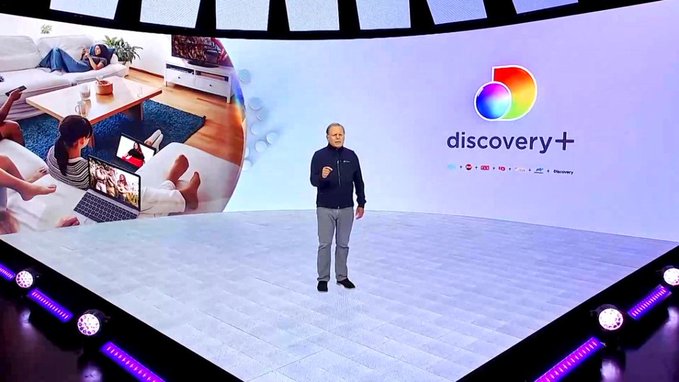Discovery CEO David Zaslav at Discovery Plus event on Dec. 2. (Image credit: Discovery)
By
Source: www.nexttv.com, December 2020
How many folks will pay $5 a month for the privilege of watching basic cable shows on demand? And what does this service have that the cheaper CuriosityStream doesn’t?
So Discovery finally pulled back the curtain on its brand-unifying subscription VOD service, announcing a hybrid business model, wireless carrier bundle, outside content partners, but sharing few details on where, exactly, Discovery Plus (aka “discovery+”) will debut in about a month.
Nonetheless, the company said Discovery Plus is ready to take on a stout array of bigger, already entrenched competitors in the battle for American eyeballs and wallets, a domestic addressable market its executives put at 70 million households.
But here in what can only be called Peak Streaming Wars, as we head into a punishing winter of pandemic surges, political transition and economic uncertainty, and after just about every other major media company has already carved out a streaming niche, it’s worth asking whether Discovery Plus is already too late.
Will anyone, or enough anyones to make financial sense, line up to pay $5 a month (with ads) or $7 (ad free) for the privilege of watching basic-cable shows on demand? Millions of households have already spent months or years getting used to watching either premium services such as Netflix and HBO Max, or free ad-supported alternatives such as Tubi and Pluto. Along the way, those audiences have been cutting cable cords at record rates, a trend that seems likely to continue.
Discovery Plus, its executives contend, will counter those challenges with a vast trove of content, some 55,000 episodes from 2,500 mostly unscripted shows from Discovery Channel, Animal Planet and new partners A&E, the History Channel and Lifetime. All those networks have found strong niche audiences in the cable era, folded into the broader cable bundle.
Now Discovery Plus must reach those audiences on a new platform, with different audience expectations. It must not only get audiences to pay specifically for Discovery Plus. It must also keep serving up content that will keep them there. That requires a different set of skills, particularly when it comes to creating programming worthy of tuning in when there are so many attractive, well made and heavily marketed options elsewhere. Will seven days of “Shark Week” be enough?
Worse, Discovery can’t even own the non-fiction programming sector it pioneered, thanks to its own founder and long-time CEO, John Hendricks, who created CuriosityStream five years ago as essentially Discovery 2.0, minus the strictures and limitations of traditional pay TV. In many ways, it’s the company Discovery should have launched (or bought) two years ago.
CuriosityStream has much the same approach to what Hendricks calls “factual programming,” and it doesn’t even cost as much. Even the basic HD-only tier is ad-free, and costs half the price of Discovery Plus. Its 4K stream is cheap, too, just $53 a year during a holiday promotion.
And it’s safe to say CuriosityStream is ready to take on the newcomer. It released a quick statement after the Discovery Plus announcement with some key points about what Discovery Plus faces when it finally arrives:
“CuriosityStream was built to fulfill an absence in the market of a factual streaming service focused on quality unscripted and uncontrived content,” the company said. “As we’ve seen in the recent past, many broadcast and cable brands must contend with legacy TV assets and myriad rights obligations as they attempt to accelerate their move into the direct-to-consumer world. As a streaming pure-play, we are free of these challenges and able to scale our business based on audience needs. Our focus is on continuing to curate an unrivaled nonfiction library and leverage our diversified distribution models to serve up the best factual content experience in the world.”
That hits the real challenge facing not just Discovery but all the Hollywood studios, who’ve each gone through wrenching streaming-first reorganizations this year: how do you maximize your old business models while building competitive offerings in the new one?
While that’s been a harrowing transformation even for Disney, as witnessed by its latest corporate shuffle the same day as the Discovery Plus announcement, the smaller cable-first companies face an even stouter challenge, compounded by their slow arrival in the market against deep-pocketed competitors.
Paramount Plus, the rebranded and beefed-up version of ViacomCBS’s CBS All Access, also won’t arrive until early next year. But at least it’s built on a well-established if smaller service, and will feature an Enterprise ship’s worth of Star Trek series, Emmy contenders such as The Good Fight, NFL games, CBS news and all those Viacom channels.
Discovery Plus’s best chance might be making like a cable service, again, and bundling with complementary competitors. That explains the programming partnerships with Lifetime, et al, and very much the deal with Verizon to give away Discovery Plus to that carrier’s 55 million subscribers.
Other media companies are bundling as fast as they can, too, hoping to drive revenue, save on marketing and build consumer awareness and sampling.
Even Disney is heavily marketing its ESPN Plus/Hulu/Disney Plus bundle. Expect more such deals, for just about everyone not named Netflix, Apple or Amazon.
Of course, the other bundle that matters is the one about which Discovery was silent: where can you access the service. Both HBO Max and Peacock were initially hobbled by carriage disputes with Amazon Fire and Roku, showing that distribution deals matter even in a post-cable world.
That Discovery Plus executives were silent about its distribution partners suggests many more conversations will be held between now and Jan. 4. It also suggests that just like in the old days, fights over carriage remain even as the old cable bundle heads to the ash heap of history.

